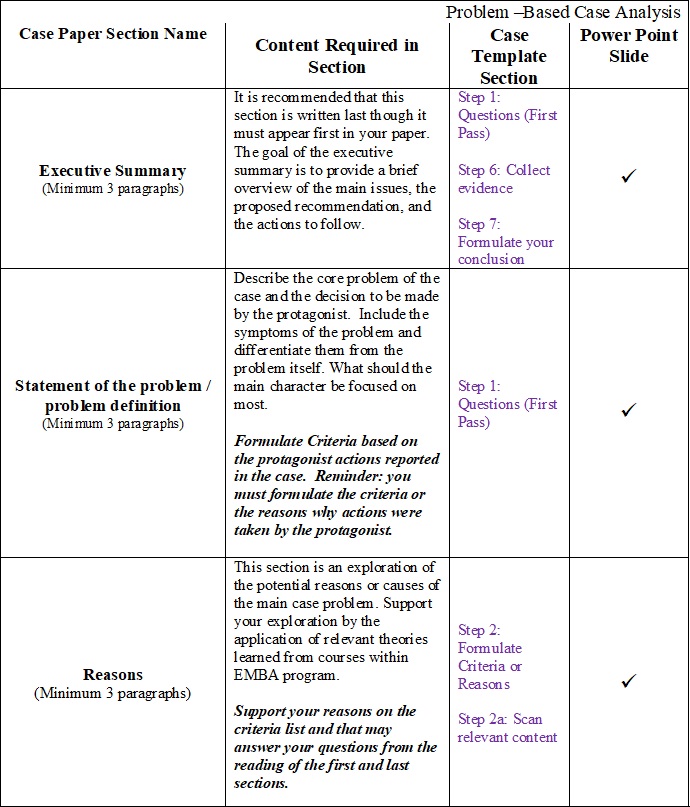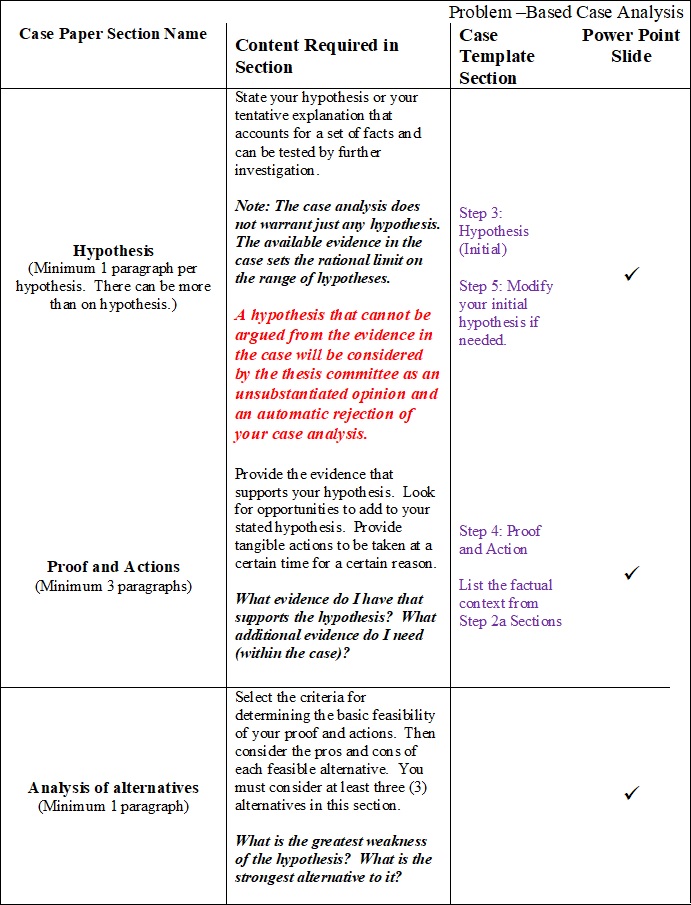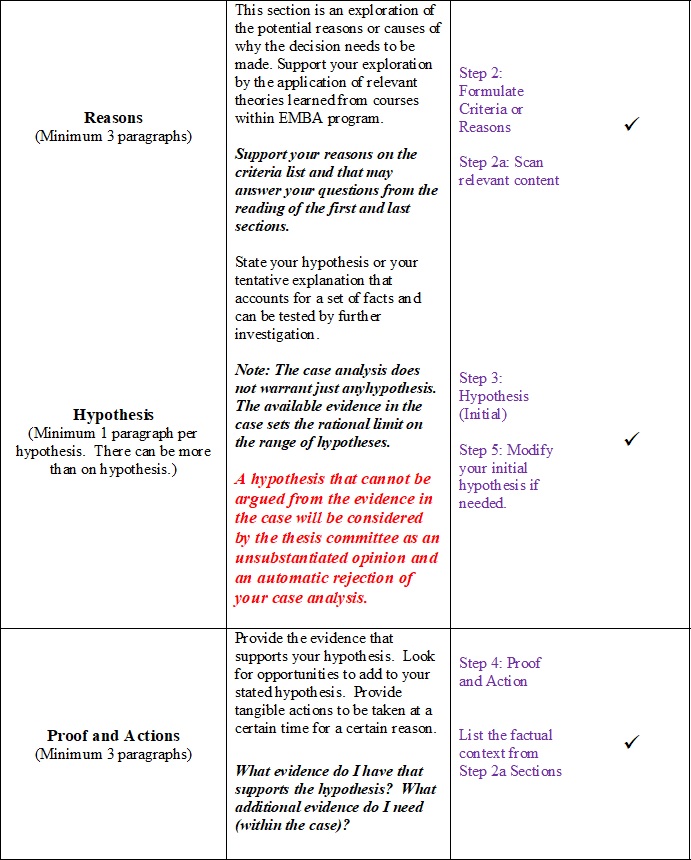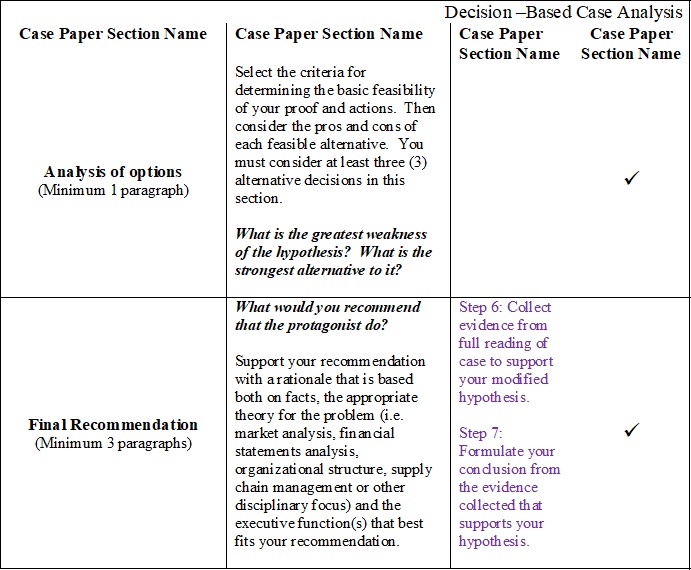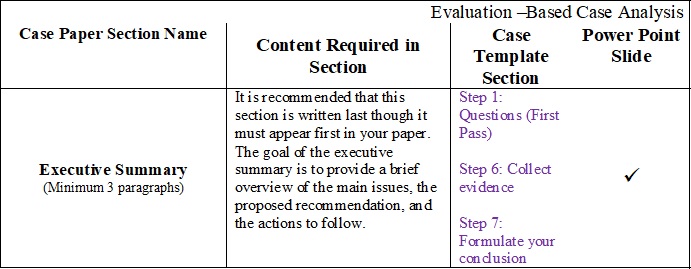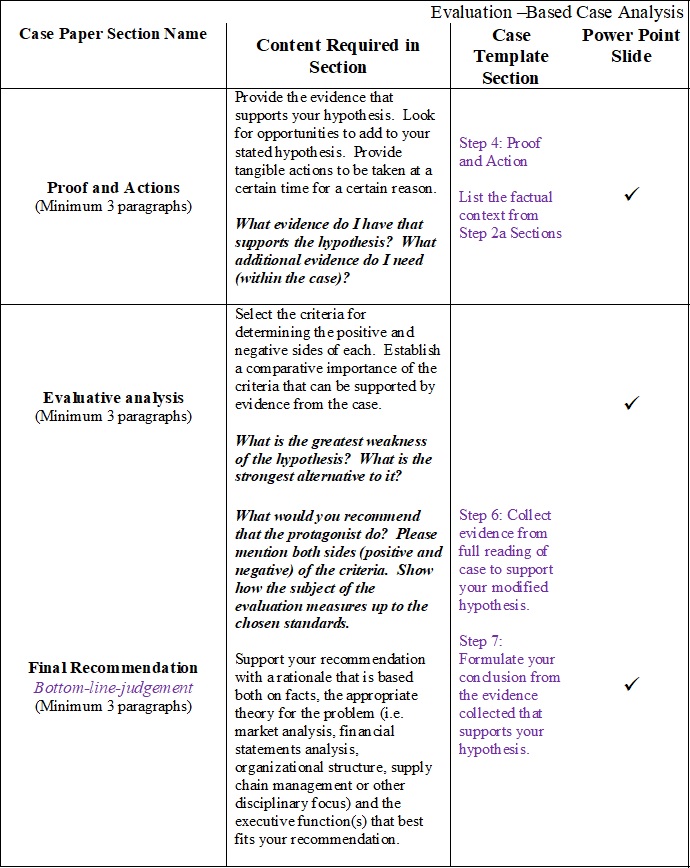- Case StudyHelp.com
- Sample Questions
Looking for BUS504 Criteria for Case Analysis Paper with Sample? Get the Best BUS504 Case Analysis Paper Assignment Answer from Case Study Help Experts in Australia, UK, USA and Others. We Provide Excellent Academic Writing Services at the Best price for College & University Students. Order Now Today!
Criteria for Case Analysis Paper
Outlined below are the mandatory criteria for the case analysis paper to be considered for fulfillment of BUS504 Case Project. Failure to adhere to these criteria will result in rejection of the case analysis paper by the assignment review committee, postponement of presentation defense or “F” grade for BUS504.
- Case analysis adheres to the manuscript preparation guidelines explained below.
- Case analysis should be in Microsoft Word format only.
- Each case analysis should be accompanied with a cover letter. For more details, refer the cover letter guidelines below.
- The case analysis should be written in single column format, using Times New Roman font, 12-point font size. Keep the layout of the text as simple as possible.
- All figures provided are of high resolution, preferably 300dpi
- References should follow the APA Guidelines version 6 or higher.
Case Analysis Paper Preparation Guidelines
A case analysis paper submitted to BUS504 Case Project assigned review committee should conform to the guidelines indicated below. Before you submit, please study the author checklist provided at the end of this document. Following is the chronological order of topics to be included in the case analysis paper:
- Title – (Title name provided by Deanship of Graduates Studies and given to the Program Coordinator. It cannot be changed.)
- Abstract
- Executive Summary
- Statement of the problem / Statement of the options / Statement of the criteria
- Reasons / Terms
- Hypothesis
- Proofs and actions
- Analysis of alternatives / Analysis of options / Evaluative analysis
- Final Recommendation
- References (the only references outside of the evidence in the case, in which the author is confined to, are concepts from courses taught inside the program.)
Cover Page
The cover page is provided by the program coordinator. Please use the cover page template provided.
Electronic Formats
EMBA candidates are requested to send their articles in MS Word (.doc) format to their advisor for review and submission to the assigned review committee chairperson. In case of any difficulty with the manuscript submission process or concern regarding the suitability of your files.
Article Title
The title should be concise and specific to the topic of the article, avoid using abbreviations in the title. Titles should be presented in title case, meaning that all words except for prepositions, articles, and conjunctions should be capitalized.
E.g. An Experimental Study of Classification Algorithms for Crime Prediction
Abstract
The abstract introduces the article and should not exceed 300 words. It should mention the techniques used without going into methodological detail and should summarize the most important results. Please do not include any citations in the abstract and avoid using abbreviations if possible.
Executive Summary
It is recommended that this section is written last though it must appear first in your paper. The goal of the executive summary is to provide a brief overview of the main issues and evidences, the proposed recommendation, and the actions to follow. The executive summary should not exceed 3 paragraphs. Please do not include any citations in the abstract and avoid using abbreviations if possible.
Statement of the problem / Statement of the options / Statement of the criteria
Statement of the problem: Describe the core problem of the case and the decision to be made by the protagonist. Include the symptoms of the problem and differentiate them from the problem itself. What should the main character be focused on most.
Statement of the options: Describe the options of the case and the decision to be made by the protagonist. Include the expected impact of the decision and why the decision needs to be made. What should the main character be focused on most.
Statement of the criteria: Describe the core criteria of the case and the basis upon which an evaluation is to be made by the protagonist. Make sure the criteria selected meet the 3 guidelines below:
- Relevant to the performance and situation.
- Select a minimum number needed for a credible result.
- They are productive when applied to the case.
This section must also include the author’s formulate criteria or reasons for the protagonist actions reported in the case. Note as it pertains to this section: It is not a requirement that your reasons are based on evidence in the case. It is the author’s(the writer of the case analysis paper) reasons why actions were taken by the protagonist. The statement of the problem, statement of the options, or statement of the criteria should be at a minimum of 3 paragraphs.
Reasons / Terms
Reasons: This section is an exploration of the potential reasons or causes of the main case problem. Support your exploration by the application of relevant theories learned from courses within EMBA program.
Terms: This section is an exploration of the terms to be used in the evaluation. For example, a performance appraisal, ISO worksheet or SOW (Statement of work). Support your exploration by the terms based on relevant theories learned from courses within EMBA program.
The reasons or terms should be at a minimum of 3 paragraphs.
Hypothesis
State your hypothesis or your tentative explanation that accounts for a set of facts and can be tested by further investigation.
The case analysis does not warrant just any hypothesis. The available evidence in the case sets the rational limit on the range of hypotheses.
A hypothesis that cannot be argued from the evidence in the case will be considered by the case review committee as an unsubstantiated opinion and an automatic rejection of your case analysis paper.
The hypothesis should be at a minimum of 1 paragraph. The author can have more than one hypothesis.
Proofs and Actions
In this section provide the evidence that supports your hypothesis. Look for opportunities to add to your stated hypothesis. Provide tangible actions to be taken at a certain time for a certain reason.
The Proofs and Actions section should be at a minimum of 3 paragraphs.
Final Recommendation
Support your recommendation with a rationale that is based both on facts, the appropriate theory for the problem (i.e. market analysis, financial statements analysis, organizational structure, supply chain management or other disciplinary focus) and the executive function(s) that best fits your recommendation. The Final Recommendation section should be at a minimum of 3 paragraphs.
Headings
For a better understanding of the content in the article, we encourage authors to number the article headings in Arabic style format. Headings should follow title case, meaning that all words except for prepositions, articles, and conjunctions should be capitalized. All botanical names should be in italics.
For example: 1. Finite Element Modelling (FEM)
1.1 Model Description
Abbreviations
All abbreviations should be defined on first use in the text along with the abbreviation in parenthesis. E.g. Magnetic Resonance Imaging (MRI)
Units and Symbols
Symbols should be used while referring to alpha, beta, mu, etc (Ex: α, β, µ, etc). All units to follow the International System of Units (SI units)
Figures: General guidelines
- Figures Format & Resolution: Authors are requested to supply high-resolution versions of the figures in TIFF, JPEG or EPS format. We require that figures be created at a minimum resolution of 300 ppi.
- File size: The file sizes should not exceed 20 MB.
- Figure captions: These have to be included in the text and provided sequentially at the end of the article. The captions should be short having 10-15 words in sentence case style. E.g. Figure 1. Percentage of detection rate vs. number of nodes.
Tables: General guidelines
- Tables should be included in the text file at the end of the article.
- All tables should have a concise title and written as Table 1 with a period (.).
E.g. Table 1. Stimulation settings - Footnotes can be used to explain abbreviations. Tables extending beyond 1 page should be avoided.
References
- In text citations: References cited in text should conform to the APA Referencing Style (version 6 or higher). Please refer the Purdue University Writing Lab website for guidelines:
- Reference List: This should only contain references to those works which you have cited in your text from sources used within the EMBA program courses. It should appear at the end of your text. It should be arranged numerically by citation number.
BUS504 Based Case Analysis Project
The following sections are required for the Problem –Based Case Analysis:
For REF… Use: #getanswers2001530



